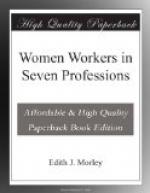WOMEN AS SANITARY INSPECTORS AND HEALTH VISITORS
The introduction of women into the public health service is a modern development, although they have been engaged in it longer than is usually known.
Women who are employed in Public Health Work hold office under Local Sanitary Authorities, and their work must not be confused with that of the Women Home Office Officials, who were first appointed in 1895; these inspect factories and workshops, but their powers and duties are of a different character. For instance, the Women Home Office Inspectors deal, amongst other things, with the cleanliness of factories, but not with the cleanliness of workshops, and with the heating of workshops, while the ventilation of the same workshops is under the control of the local sanitary officials.
Glasgow was the first county borough to utilise the services of Women Health Officials, for in May 1870 four “Female Visitors,” afterwards known as Assistant Sanitary Inspectors, were appointed in connection with the Public Health Department. Their duties were: “by persuasion principally, to induce the women householders to keep the interiors of their dwellings in a clean and sanitary condition, and to advise generally how best this can be maintained.” They possessed the same right of entry to premises as the men inspectors, and were required to hold the certificate of the Incorporated Sanitary Association of Scotland. They reported certain nuisances, but themselves dealt with others, such as “dirty homes or dirty bedding, clothing, and furnishing.”
The work of Women Health Officials in England, dates from the passing of the Factory and Workshops Act of 1891, when certain duties with regard to workshops, which had previously been performed by the Home Office Inspectors, were laid upon Sanitary Authorities.
In the opinion of Dr Orme Dudfield, late Medical Officer of Health for Kensington: “It soon became apparent that, not only was systematic inspection necessary, but also that many of the duties involved were of so special and delicate a nature that they could not be satisfactorily discharged by male inspectors.” He therefore recommended the appointment of two Women Inspectors of Workshops in Kensington. In the meantime the city of Nottingham had appointed a Woman Inspector of Workshops in May 1892, and in accordance with Dr Dudfield’s recommendation two Women Inspectors were appointed in Kensington in 1893.
These ladies were appointed as inspectors of workshops only. They did not hold Sanitary Certificates, nor had they the status of Sanitary Inspectors. In practice, this entailed a visit by a male inspector every time it was necessary to serve a legal notice for the abatement of any contravention of the Factory and Workshops’ Act. Therefore, when these ladies resigned upon their appointment as Factory Inspectors, it was decided to appoint the in-coming ladies as Sanitary Inspectors, with power to deal with these matters themselves. It was, however, Islington which appointed the first woman with the legal status of Sanitary Inspector in 1895.




